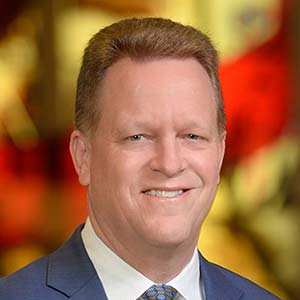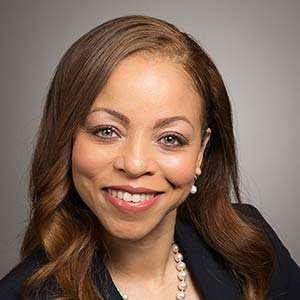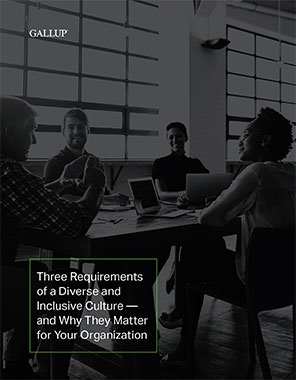A Conversation With Steve and Joy

Steve Fry
Senior VP of HR and Diversity, Lilly

Joy Fitzgerald
Chief Diversity Officer, Lilly
In 2015, global pharmaceutical company Eli Lilly and Company began a research study unlike any of the thousands it had conducted in its 140-year history when it sought to discover why so few Lilly women were reaching top leadership positions.
That initiative, called the Women's Journey, used the exacting research standards of a world-class scientific organization, but it also asked "highly personal questions," as Lilly's Chief Diversity Officer Joy Fitzgerald put it, of the 400 leaders in the study. The resulting quantitative and qualitative data gave Lilly executives deep insights into the lived experiences of women in the company, such as the finding that women's perceptions of their roles at work begins in adolescence, long before they start their careers.
The data "created an energy for change that we had never experienced before," according to Steve Fry, Lilly's Senior Vice President of Human Resources and Diversity. Indeed, executives and employees were so enthusiastic about the study that Lilly soon launched a "Journey" on the experiences of African Americans at Lilly, then Hispanic/Latino employees, then Asians and now LGBTQ employees.
Each of these Journeys is different, as Fitzgerald and Fry relate in this CHRO Conversation, but they all offer leaders deep insights and a trove of data that informs their inclusion strategies -- which are already succeeding as the percentage of women in leadership is rising, and ethnic minorities are joining leadership in greater numbers, too.
That's a testament to Lilly's commitment to inclusion. But the trust, generosity and faith Lilly's people show by giving honest answers to "highly personal questions" is a testament to Lilly's 140-year-old culture -- and the leaders who launched these extraordinary studies.
Emond: Tell me about Lilly's Women's Journey. How did that come to be?
Fry: When we're working on a therapy, we seek to understand patients' real, lived experiences and what we call "moments of truth" where a patient just fundamentally struggles in their disease progression and treatment. We want to ease the moment to make it better for the patient. The idea was to do that here, to use our own best research tools, to understand the "moment of truth" in the real, lived experiences of our employees.
Our first Employee Journey started in 2015 to understand barriers to the advancement of women at Lilly. It resulted in what I would call the largest quantitative database we've ever done, but the qualitative piece was just as substantial -- it included journaling, storytelling and focus groups. But I kind of think it was the stories Lilly women told that really connected senior leadership to individual people. I think if we'd only had the quantitative data, it wouldn't have created so much change.
Emond: We've learned at Gallup over the years the qualitative piece is really powerful. Take us through how you proceeded from there.
Fry: When we'd finished the qualitative and quantitative collection, we spent four hours with our executive committee going through both, connecting them to what we learned. It created an energy for change that we had never experienced before. That led to our first two-day innovation lab with roughly 70 women across the company at all levels cross-functionally, two executive committee members, leaders from our Women's Network, our Global Diversity office, myself, and leaders from our HR organization, including Joy, to ideate on things we could do to make improvements.
Fitzgerald: The primary purpose of the innovation lab was, as Steve said, to introduce all of the data and key learnings from the research to ground everyone, and to provide an environment that allowed for the uncomfortable but safe conversations around what we needed to do. We want to continue to do the great things Eli Lilly does, but we also want to fundamentally change some of the tensions we saw in the data.
Innovation labs allow us to learn from each population we study by bringing together a diverse group of senior leaders and early career professionals to dig deeper and get more clarity than data can provide -- innovations labs are a place to say, "Help me understand." So, we have breakouts for deeper conversations around key data elements on the first day and discussions around solutions on the second day. We talk about what would need to exist so that, if we were to come back to this room in three years -- and we were intentional to say three years, because we wanted to make it actionable immediately -- we would have a very different conversation.
With the women's study, we came out of the two-day innovation lab with five key recommendations for our CEO and his direct reports to take on as a corporate project.
Fry: Which led to a lot of the changed agenda that we have had the last few years.
"Do you care enough to ask questions about the whole me?" is a core tenet of inclusion. We really do care. And we communicated it. We communicated to everyone that we were on a journey to learn.
Fitzgerald: We were fortunate that Dave [Lilly CEO David A. Ricks] was the sponsor of our Women's Network at the time, and he, along Steve, had a real sense of urgency to take one of our core business processes and replicate it through the lens of diversity and inclusion. That made women and men, because we asked these questions of men as well, feel valued in a very different way. That investment also sent a strong message to our broader employee population about how important we believe D&I are to our business.
In other companies, it can be hard to move from diversity practitioners to inclusion practitioners in a real way. It can be hard for employees to understand. But the power of the data gave us a different business case -- one of the study's key insights was that, all across the world, regardless of culture or geography, women are the Chief Medical Officers of their families. Their everyday decisions help people live longer and healthier with a better quality of life. So, how are we leveraging that thought equity, what insight can women bring relative to gender? Are women holding the positions that help us win for patients? I think asking those questions brought about a different conversation for us, especially about the "moment of truth" Steve mentioned.
Fry: And since then, we've done studies on our African American, Asian, Latino and LGBTQ populations, and people have really trusted us with their stories because they believed we would do something good with them. Most of the time when we're taking surveys at work, it's really just about our experience here at work. Employee Journeys are about the "whole you," not just the "producer you." That's how we framed this, which was a really important part of why they were so successful. "Do you care enough to ask questions about the whole me?" is a core tenet of inclusion. We really do care. And we communicated it. We communicated to everyone that we were on a journey to learn.
Emond: This could not have been a quick process.
Fitzgerald: We spent significant time; this wasn't rushed work. There were a number of ways we went about trying to understand these experiences. We're a company that's built on data, so we used the same rigor that we use with our business process. And we incorporated outside data too, such as research on adolescence to understand the values taught to girls that might be different from the values taught to boys. How do those lessons shape how adult women show up in our company? How does that affect their decisions and choices relative to their careers? I don't think I've ever seen a workplace study that included information like that -- not just employees' experience here, but really their life experience.
We walked into it with the attitude that we were going to listen in a place of no judgment or excuses. We wanted to honor the brave individuals inside our company who trusted their life stories and experiences with us. Then, our most senior executives came together in the innovation lab to talk about the research and their own lived experience -- the things they love the most about this company and what's working well for them. But also, some negative things people experience throughout their careers -- things like imposter syndrome, stifled authenticity, the idea that women have to act like men to succeed. That changed the game.
Fry: Some people were all in, really excited to share their journey. Some just wanted to wait and see how it was going to turn out. And some were very uncomfortable discussing their experiences. But I don't know of one individual who wouldn't say this was one of the best experiences they've had in their career. We heard things like, "I had no idea I would learn the things I've learned," "This was uncomfortable at times, but also needed," and, "It wasn't always easy but we grew as individuals." I certainly won't forget any innovation lab I've been in and what I've learned in each and every one of them.
Emond: How many employees had you, up to that point, talked to either quantitatively or qualitatively?
Fitzgerald: At that point, roughly 400.
Emond: What's happened since that time?
Fry: We've seen the number of women leaders at Lilly rise, but those numbers were not our targets. We don't have quotas. We have aspirational goals and we achieved them. I think that's a very important thing to understand. But if we had just kept doing things the way we had been, we wouldn't have come close to achieving those aspirations.
Emond: Tell me about your Minority Journey studies.
Fitzgerald: We talked to roughly 5,800 employees for our African American Journey, Asian Journey, and Latino/Hispanic Journey. And recently we kicked off a new Journey of our LGBTQ population. We may do more -- I won't say any group is off the table -- but each Journey presents new challenges for the individuals and for collecting the data.
In fact, when we were trying to figure out what we would call the studies, we even debated calling them a "Minority Journey" at all. Asians, in particular, don't always identify as a minority. And our Asian population is so big and so diverse, and the experiences of Asian Americans and recent Asian immigrants aren't the same, so we had a lot of questions around pulling the data together -- I mean, would we find anything people had in common? We had to decide how we were even going to talk about this. But we were very clear we would follow the data. That's why it's so important to be careful about every word -- otherwise you might bias the data. And we were able to find, with statistical significance, there were common themes in our overall Asian population, which surprised some people, I think.
The Hispanic/Latino study was complex, too. Some Latinos don't identify with a race at all, there's an historical division between Hispanics and Latinos that started centuries ago but is still felt, there's classism and colorism involved, so intersectionality is an issue we had to examine. But we discovered common experiences among the whole group, regardless of those different dynamics. In any case, we will continue to advance our strategy of understanding our populations at a deeper level. How that might happen is yet to be determined.
Emond: Getting people to open up about such personal information isn't easy. There are some trust issues involved, I imagine.
Fitzgerald: That took some work. Not because there was distrust, but what people shared was personal, as you said, and most people really don't want to be personal at work. It just doesn't seem appropriate. I think participation was high and our employees opened up because our employee resource groups and minority group members saw how positively senior leaders responded to the Women's Journey and the urgency to make progress. Everyone knew that, to make the biggest difference, we needed to do something fundamentally different. This was our chance to move the needle fast, so we're going to have to all get involved and share. That was the framing around this.
More so than they did two years ago, people feel they can be their whole self at work. So, a sense of authenticity is growing. And people say they feel more comfortable sharing ideas and speaking up, even when they think that others might disagree.
Emond: How have your ethnic minority numbers evolved since that study?
Fitzgerald: They've improved as well. In the U.S., women of color in management have increased across the board. At just the vice president level, a 120-person group, we went from 3% to 9%, which is quite significant in such a short amount of time. We've seen a 20% increase in African Americans, Asians and Latinos in management, too.
Emond: Looking back, what were your biggest findings?
Fry: There were a lot. But to start with, Latinos described, more than any other group, the impact of public policy on our employees -- immigration laws especially. We do not hire people who don't have authorization to work in this country. They're not candidates. But the whole conversation around immigration has an impact on our employees who are here legally or who are citizens. They get comments about taking a job from an American. They get asked why they're here. Their kids have been called things.
With the Asian Journey, we learned that people often feel valued for their technical ability but not appreciated for their leadership capability. That was huge.
One of the things that we learned in the African American Journey was around psychological safety. So we designed a complete action plan around making our workplaces more psychologically safe. And the issue of social distance was more pertinent for the African American community. There were certainly commonalities amongst all the Journeys, but we learned unique things from each of them.
Emond: Explain social distance.
Fitzgerald: Think of it as a "living room" or maybe "locker room experience" -- social interaction in places where people meet for a purpose that isn't about work. Men are likelier to have a social connection across ethnic lines with other men -- such as in their team's locker room -- so less social distance. African American women are not likely to have locker room or living room experiences with white men, so there's a lot of social distance there. Social distance and the absence of experiences where people can connect as people may lead to discomfort in establishing relationships in a work setting.
Emond: How did you relate to the organization what you learned from these Journeys?
Fitzgerald: We took a top-level down approach. We started with our most senior leaders. All of our executive lead team have spent three to four hours at a minimum going through each one of those Journeys. We didn't combine them -- our leaders did African American, Latino, Asian and Women's Journeys separately, which resulted in some pretty robust conversations. Then, many of the executives had those same types of meetings with their team leads.
Then, when we finish all the data for each Journey, we have a rollout in which all of our U.S. employees are invited to a kickoff and a culminating event a month later. There are between seven and nine events during that month that employees can attend either virtually or in person that highlight all of the key findings, and events where individuals share their stories. And we created videos that are available to all of our employees. And we have toolkits for each one of our Journeys on our intranet.
We also created an immersive experience, a big display, that travels to our various sites that people can visit with their team, listen to the videos, have discussions, dialogue. People have found it to be highly valuable. And each of our ERGs (employee resource group) were key stakeholders with us throughout the entire project. They actually serve on our advisory committee. So when they work on their yearly annual plans for their ERG, they're connecting their work to the Journey and the learning. That keeps it top of mind, but also ensures education.
Emond: Have you measured employees' perceptions of diversity and inclusion? And how the company's doing with its commitment to that?
Fitzgerald: A couple of things stand out. More so than they did two years ago, people feel they can be their whole self at work. So, a sense of authenticity is growing. And people say they feel more comfortable sharing ideas and speaking up, even when they think that others might disagree. We've made significant progress on those issues.
Fry: A real historical comparison is tough because we rolled out a new Team Lilly Framework, which communicates the core components of our culture, our longstanding values of integrity, ethics, respect for people. The basics are the same. At the top is our purpose underlined by the culture we're trying to create, underlined by the experiences we want to provide employees and customers, underlined by the results we're trying to produce as a company. But the Framework also clarifies the expectations of every employee: accelerate, innovate, deliver and include. The word "include" is new, which is why we really can't do a perfect year-over-year comparison. The Framework used to have "connect" but "include" is broader. Still, the "include" score went from 70% positive to 76% positive. So, I think that's evidence that we really are changing the dynamic and the culture of the company and the experiences that people have within it. We need to measure that over time.
Fitzgerald: I think when people saw improvement after the Women's Journey, they saw that we can make a change and that Lilly is 100% committed. And I've just been so pleased with all of the support people are giving the LGBTQ Journey. That's because of everyone who went before. They were really brave. And now people are saying that it's working and that we're getting results. I can't think of a better response than that.
Explore other CHRO conversations:
- Microsoft CHRO Kathleen Hogan
- Mayo Clinic CHRO Cathy Fraser
- Roche CHRO Cris Wilbur
- ABB CHRO Jean-Christophe Deslarzes
- Roche CHRO Cris Wilbur and Global Head of Talent Innovation Tammy Lowry
- Genpact CHRO Piyush Mehta
- Schlumberger HR Chief Gavin Rennick
- Huntington Ingalls Industries CHRO Bill Ermatinger
- UBS Group Head Human Resources Stefan Seiler
- Schneider Electric CHRO Olivier Blum
Jennifer Robison contributed to this article, which was based on an interview with Larry Emond.



